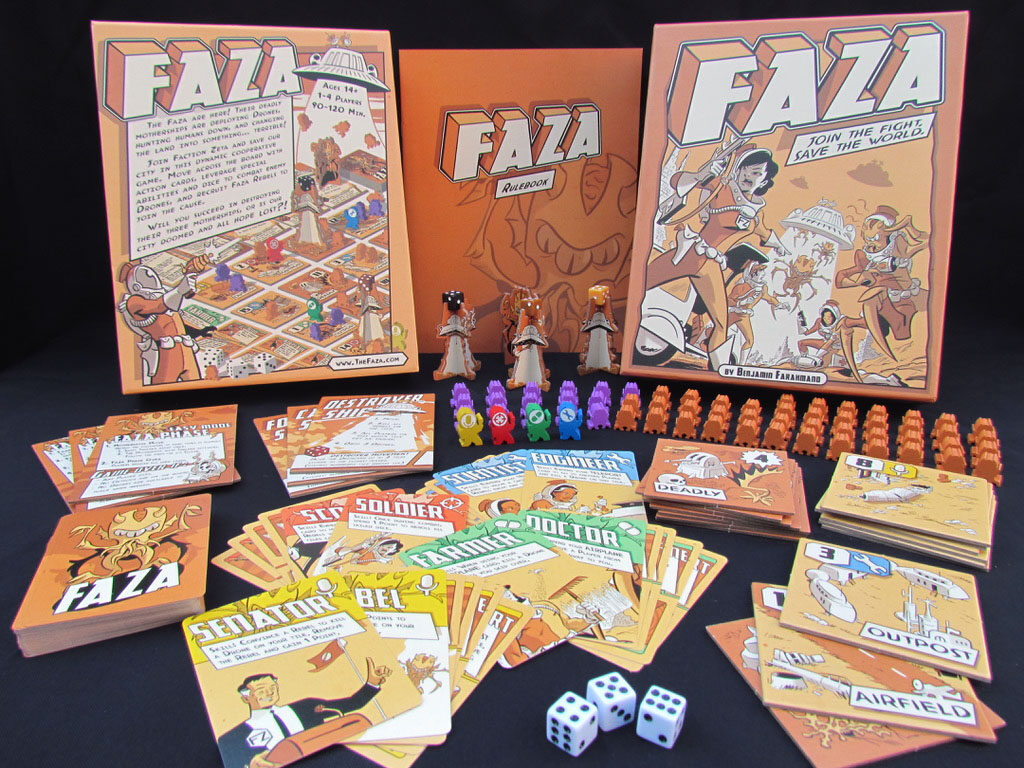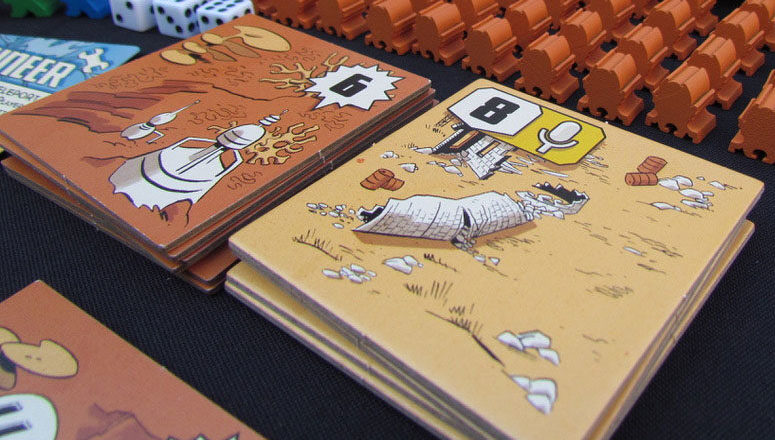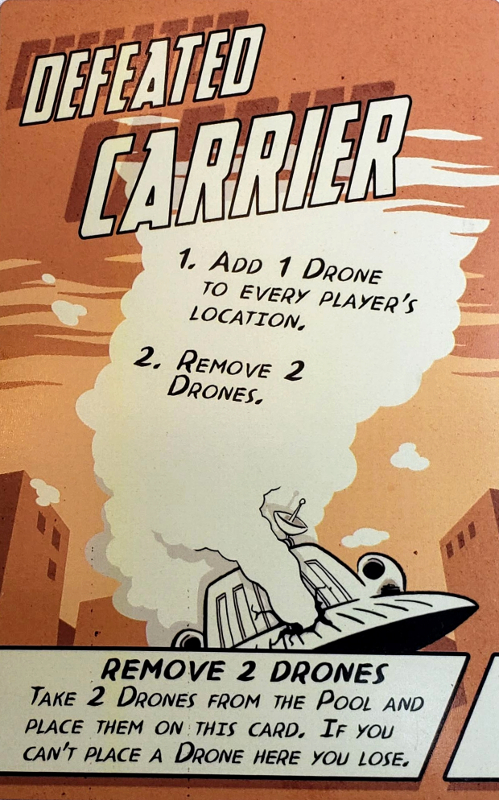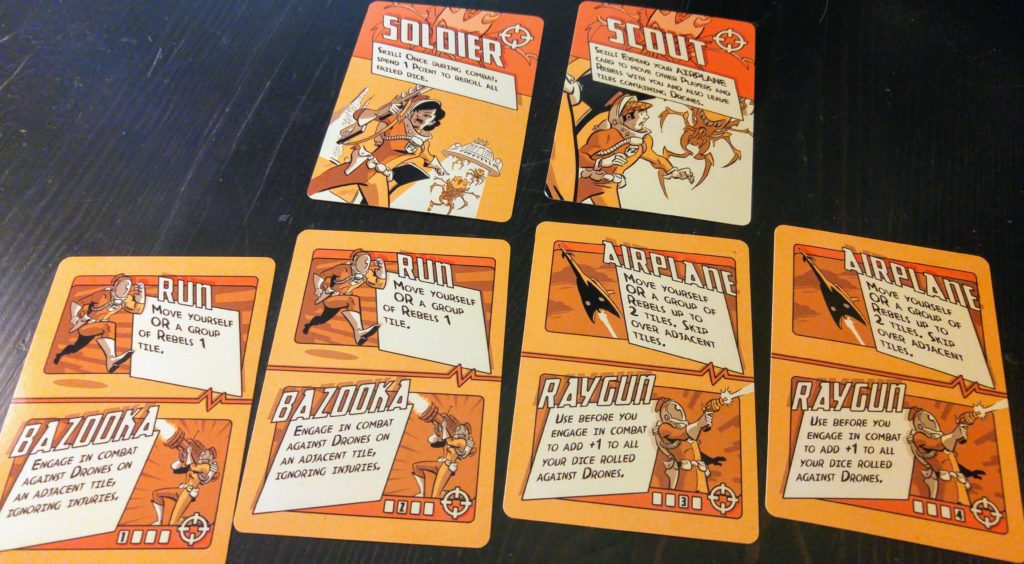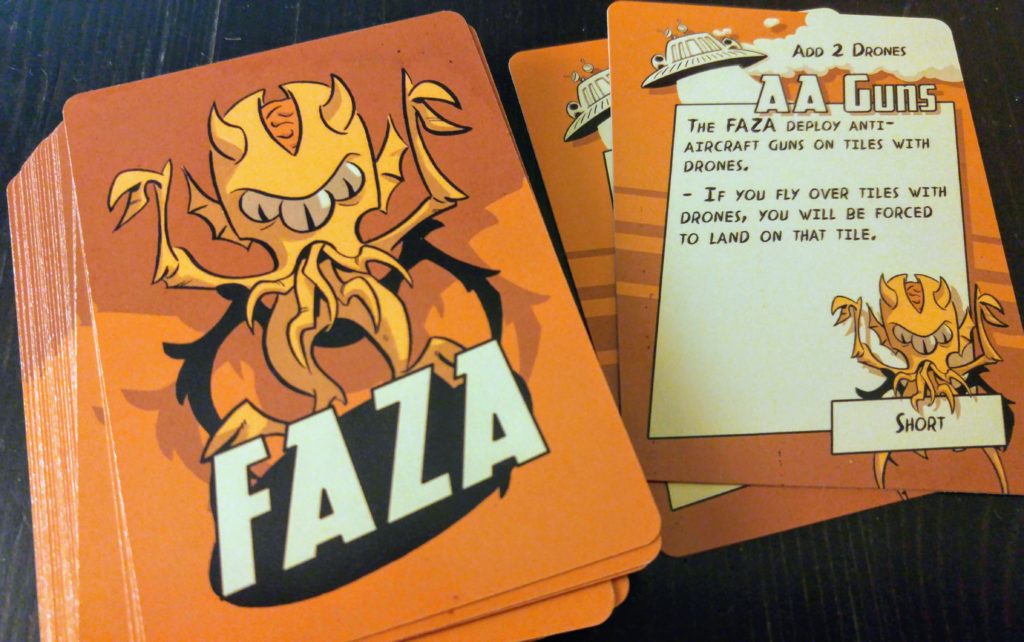As part of our October Spotlight on FAZA, we strive to inform readers of little extra tidbits surrounding the game. Games are made by people, and one of those tidbits we enjoy is learning a little bit more about the people behind them. Some designers shy away from the public stage, while others enjoy being front and center.
One of the more common traits you find when working with new designers is that nearly all of them approach releasing their first design upon the hobby with equal parts enthusiasm and doubt-laden trepidation. It’s a perfectly understandable reaction, really. For most, their first game design is literally years in the making. It is a passion project, an art project, and a test of fortitude all rolled into one final product. A product that they then foist upon others with almost no idea or control over how it will be received. A successful reaction, however modest, is enough to raise spirits and encourage designers to take another shot. A poor reaction, on the other hand, can go either way. Some learn from such failures and redouble their efforts; others walk away defeated. And until it’s thrust into the world, there’s really no way to tell. Ultimately, that first game is more than just wanting to make something to share with fellow cube-pushing enthusiasts. That first game is personal.
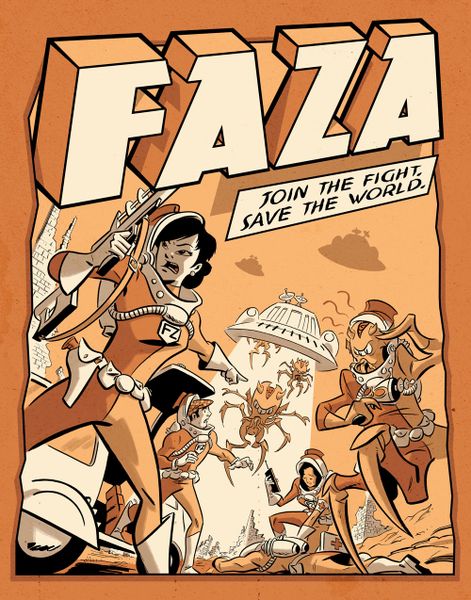
These are just some of the many thoughts that were undoubtedly felt by inaugural designer Benjamin Farahmand when creating FAZA. Driven by a desire both to create a game that fosters a better understanding of group dynamics and an artistic means to channel personal challenges into something positive, Benjamin’s trek to make this alien-hunting co-op a reality has been years in the making. In this game, aliens have invaded Earth and will stop at no
thing but the complete extermination of all life on the planet. Up against the wall, the human players must work together (with a little outside help from a rebel faction) to take down three massive motherships and save the day before their forces become insurmountable. It’s a race against time, and through a mix of teamwork and luck, you just might be able to save the day.
This familiar-yet-daunting cooperative challenge, coupled with some brilliant retro sci-fi artwork and plenty of obstacles to overcome fits right into the lightweight co-op pantheon, complete with moments of thrilling highs when you succeed and frustrating, stinging defeats when the circumstances spiral out of control. Which is precisely what Benjamin was hoping to achieve. We were curious on how its various design elements came together to make such an experience, so we set out to ask him directly. We share part of that conversation with you today.
Enjoy!
Round One Questions
CR: What was your Gateway Game?
As a child I had played the stereotypical board games like Monopoly, Life, Risk, Uno, Stratego, Battleship and also some video games on Nintendo and Super Nintendo – though I wouldn’t consider any of those my Gateway Game. It wasn’t until I started playing Chess as a teenager that I delved deep into a single game and became obsessed. During lunchtime in middle school my friends and I would hangout in our school library and train with our librarian. We eventually formed a school chess team and competed in the United State Chess Federation. My habits of playing Chess continued into high school until I was introduced to Catan…
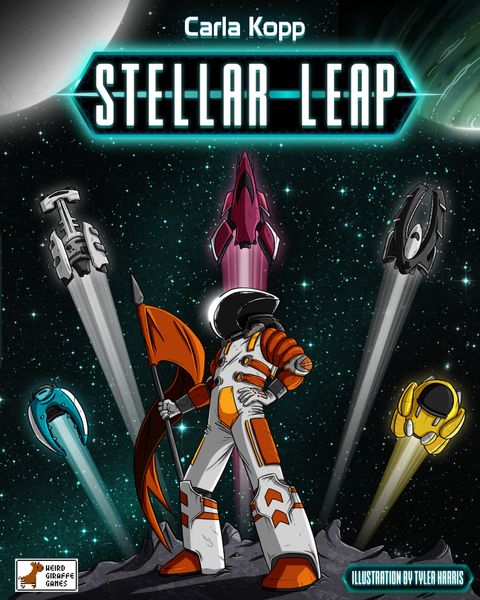
CR: What was the last game you really enjoyed playing (besides your own titles)?
The last game I really enjoyed playing was Stellar Leap by Weird Giraffe Games. I enjoy 4X games and this game has managed to condense the 4x experience into a 90 minute game.
CR: How big is your game collection?
I have 30 video games in my Steam library and 24 board games in my closet. Even then, the majority of the games I play are unpublished prototypes. I’m part of a game design group called Game Makers Guild of Philadelphia. Before the pandemic, we would meet twice a month to playtest each other’s games. Each of those nights we play about 3 or 4 different games.
CR: What is your favorite type of game to play?
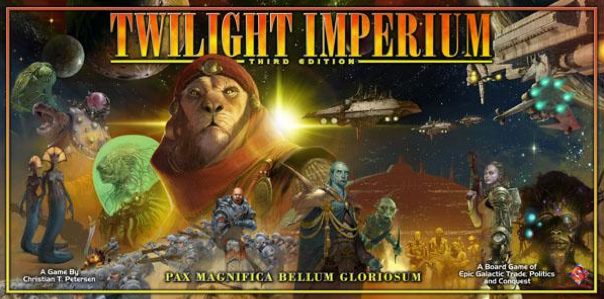
4X you say?
I enjoy many different types of games, but my favorites are definitely 4X and RPGs. While most of these games end up being on the computer, the times I’ve been able to play pen & paper RPGs at conventions I’ve walked away wishing I had a regular group to play with.
CR: How do you feel about Monopoly?
I think we should take another look at the Sherman Antitrust Act; there might be some line in there that says we should break up the game! (I’m naturally guessing other people you’ve asked have probably tried the same one-liner.) Now with that joke out of the way, my memories of playing the game as a child are filled with frustration and confusion. Frustration because I was a terrible negotiator, and confusion because I swear my friends would make up rules as we went along.
CR: They probably did!
On FAZA
CR: We have to start by asking about the FAZA name. Aside from that it’s fun to say, how did you come up with the name and what made you decide to use it for a space alien invasion theme?
After coming up with the sci-fi theme of space aliens and human survivors, my wife provided the initial direction to explore words in Farsi, which is the native language of Iran and my rusty second tongue. I began listing out phonetic translations and found the majority of the words were too difficult for an English audience to pronounce or had too many syllables. The lone exception: FAZA.
FAZA is a phonetic translation of the word “space” – as in “outer space”. The first ‘a’ sounds the same as the ‘a’ in ‘cat’, and the second ‘a’ sounds like the ‘a’ in ‘wash’. In our context, FAZA has come to be the name of the alien species human players encounter and also the name of the game.
CR: One of the more notable aspects of the game is that FAZA can be hard. What would you say the approximate win percentage is for this co-op, and what was the process like in determining that you had reached that desired percentage?
First, I need to give a little more background on the three difficulty modes available in the game. In the early iterations, there was only one mode: Hard. It was brutal; the win percentage was around 10%. I started there and it was through playtesting and lots of feedback that I realized I needed to create easier modes. Thus were born Normal and Easy. After extensive playtesting these modes, I noticed players started to employ different strategies. This meant I stumbled on a way to scale difficulty without having to employ the tactic of simply throwing more baddies on the board. I would say the win percentage for Easy is around 60%, Normal is around 40%, and Hard is still around 10%.
CR: The game provides a freestyle turn structure for the players to coordinate their moves to that end. Was this a design decision out of necessity or preference?
In early iterations of the game I tried both a set turn order and a freeform turn order. With the freeform turn order, I noticed the game would take far less time to play through to completion. After a few playtests, I observed people saying how they feel like a tactician and that the game actually feels like war because everyone can act at the same time.
When I ditched the set turn order I observed interesting shifts in the dynamics between the people playing in a freestyle structure. Players would have more dialogue and debates about the optimal strategy, which I think is one of the most important experiences for a cooperative game.
I would hypothesize that this increase in player dialogue arose naturally because people were not passing around the metaphorical talking stick, which can be reinforced by individual player turns. I also observed power struggles between players, shifts in leadership, tension and conflict, all of which are dependent on the interpersonal relationships and the life experiences of the people playing the game.
It took me a long time to discover FAZA’s core purpose: a structured and scaffolded game to help people experience the anxiety, tension, and conflict that comes with making decisions and acting within a group. Once I discovered this core purpose, I relied on the little bit of group dynamics I studied in grad school to inform the design of the game. I wanted FAZA to be a way for people to understand that there are a range of emotional experiences that come with group life. I think people should have as much practice in this process so they can maintain a healthy awareness of their individual emotions and desires influencing their behavior within a group.
So, yes, the freestyle turn structure was intentional because it affords real-life dialogue and tension that naturally exists within a group.
CR: As Faction Zeta, each player has a different assortment of unique powers, including aids to move, attack, and heal. Were there any powers that didn’t make it into the game for one reason or another, or have the powers roughly been the same since the beginning?
Before there were Players Cards that combined hit points, action points, and skills into a single & simple system, characters used to gain levels through experience points. Players could then spend those experience points on a skill tree that allowed them to choose specializations. There used to be 10-12 skills per character that could be gained over the course of the game and there were also items and gear players could purchase. The entire character system was far more involved and was inspired from roleplaying games.
The action points, the health meter and character skills were three fully independent systems in the game. It took a lot of testing to realize I didn’t need these systems to allow people to experience the core of the game, which was creating that scaffolded group experience. So I started cutting and removing as many rules as possible that did not serve the game’s purpose. Eventually, I realized a single skill per character and a few abilities on the Player Cards were sufficient to facilitate the experience I was seeking.
CR: More than a few people make mention of the game’s Pandemic-esque style of gameplay (players working as a team to combat an automated foe that slowly cascades out of control). What do you feel particularly makes FAZA comparatively unique to it (and other lightweight co-op games)?
I’ve thought about this question a lot throughout FAZA’s design process. It still makes me feel uncomfortable to think about because at the end of the day it’s a difficult process to contribute something unique and meaningful to the corpus of games. This feeling and desire to create and contribute a new game was deeply mixed with feelings of fear and inadequacy that this game is not original enough or good enough or creative enough.
When I first started designing FAZA, I borrowed ideas and game mechanics from other digital and analog games I enjoyed: Pandemic, Defenders of the Realm, and Fallout. Once I had a working prototype, the process to find something unique involved playtesting and exploring the plethora of feedback by combining and recombining different building blocks.
The basic elements that I think contribute to FAZA’s uniqueness include the freestyle turn structure, the FAZA mothership algorithm, the apocalyptic sci-fi story, the trade-offs players have to make every time they use a Player Card, the art, the replayability, the variety of ways people can interact with each other, and the diversity of characters portrayed in the game. Taken individually, I don’t think any one of these basic elements are unique. But taken as a whole, they have become greater than the sum of their parts.
CR: FAZA comes with a wide variety of counterstrokes that the aliens make upon a successful mothership attack, ranging from fortunate, to punishing, to ridiculous – giving the game some amusingly random outcomes. Do you have any personal favorite events?
I have several favorite FAZA cards, and the one thing they have in common is a small bit of story that adds classic sci-fi flavor. There are two cards – Brainworm and Parasite – that force the player to act against their will. The Abducted card conveys how the player is abducted by the FAZA. The Loved One card is about rescuing a loved one that was long thought dead. The Wormhole card is about the FAZA opening a wormhole to an alternate reality. These cards all add a little flourish to the story.
CR: FAZA had a fairly modest – albeit successful – Kickstarter campaign. What were your hopes going into the campaign? And what was the biggest surprise you found during that process?
In my day job I work as a product manager for a small tech startup. I have firsthand experience designing and developing digital products and working with a team to bring it to market. In general, I know how difficult it is to build awareness for products. And while I had this little seed of hope buried in my heart that it would be a runaway success, I kept my expectations in check and continued putting my nose to the grindstone.
Even with my work background, the biggest surprise was experiencing how long it took to go from inception to production. Before I launched the Kickstarter campaign, I spent about 4 years designing and playtesting. I do need to add that it wasn’t a continuous 4 years of work. There were stops and starts, roadblocks and breakthroughs, with the longest period away after the stillbirth of my son a few years ago. I had to take time to grieve and take care of myself. Eventually, I got back into it and I felt I had a duty to the game to give it my all. It wanted to exist.
CR: Now since it is 2020 and all – let’s say the intrepid heroes do stop the FAZA and save the planet. What are the odds that we’ve actually seen the last of the invaders?
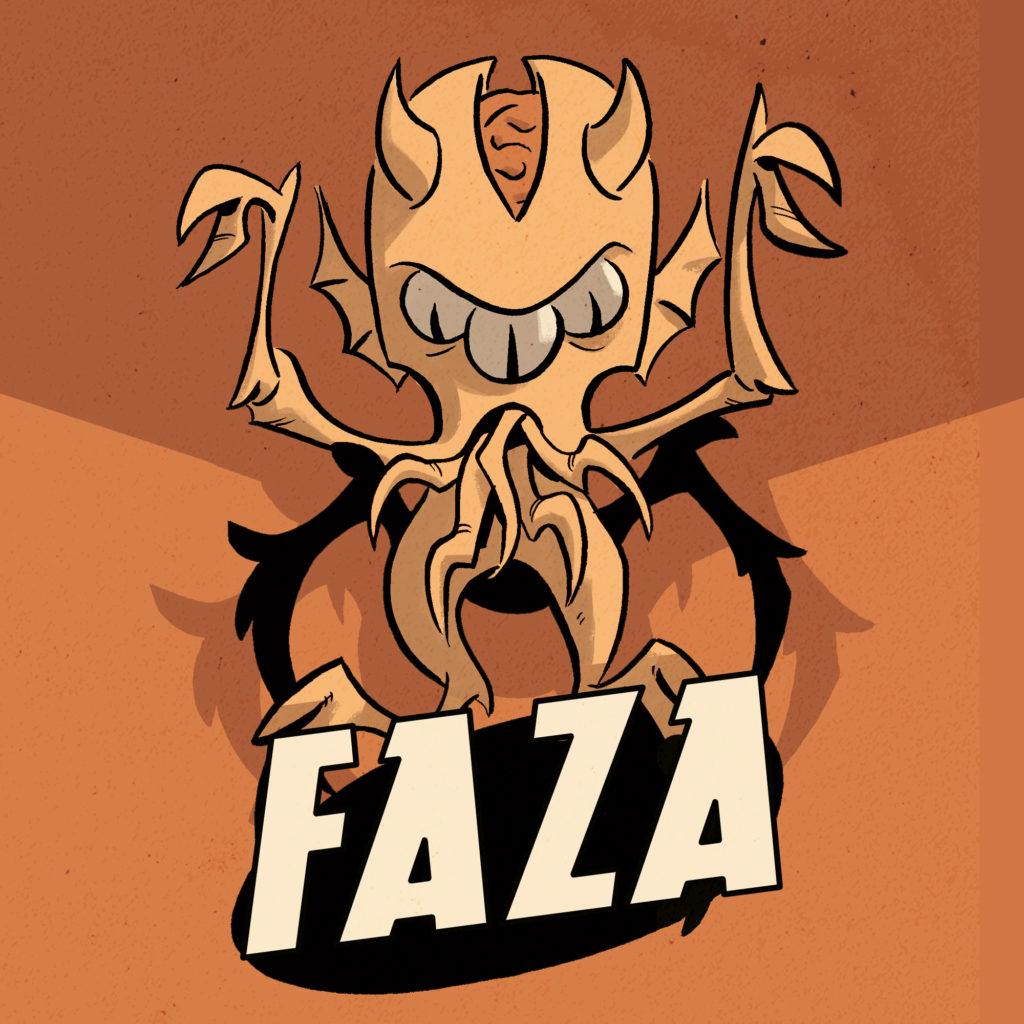 I think we’re definitely going to see them again. There are several more stories I want to explore in the FAZA universe. Some of those stories will be expansions to this game, and some will be prequels and some will be sequels with completely different game mechanics. At the moment, the main challenge is finding the space to do more game design between my day job and spending time with my wife and daughter. Not to mention, I currently can’t playtest games with people due to the pandemic.
I think we’re definitely going to see them again. There are several more stories I want to explore in the FAZA universe. Some of those stories will be expansions to this game, and some will be prequels and some will be sequels with completely different game mechanics. At the moment, the main challenge is finding the space to do more game design between my day job and spending time with my wife and daughter. Not to mention, I currently can’t playtest games with people due to the pandemic.
CR: Finally, in the game’s storyline the FAZA have been wreaking havoc on Earth for two years, which is a pretty prolonged (though slowly losing) fight. What would you be doing in that situation?
I think humans would be resilient even against an advanced technological force. We can look at a specific historical example of Europeans colonizing the Americas. While advanced technology was used by the invaders to gain a foothold, it was actually the viruses they carried that gave them the advantage. Assuming an invading ET doesn’t use a fatal virus with an extremely long incubation period, I’d like to believe humans will stand a chance.
As for me specifically, let’s say I somehow survived two years of the FAZA’s invasion. Since I also have a background in aerospace engineering, I’d like to think the most practical thing I could do to resist the FAZA is build unmanned aerial vehicles, robots, and other autonomous weapons that could be used to amplify our dwindling human forces. I most recently put those skills to use building FAZA’s robotic mascot, which can track people and interact with them as it did at the Boston Festival of Indie Games in 2018.
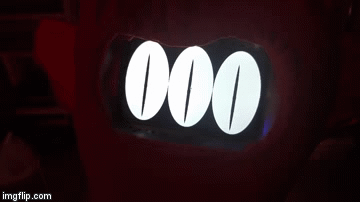
Greetings, Human…
Well, here we are. Several years into an all-our assault on our planet by a relentless force ravaging everywhere it goes. Our leaders have been incapable of stopping it or rallying behind a winning strategy. The populace, half scared and half mad, are scattered and divided on a proper course of action. The military is doing what it can, but the best they can manage is keep the situation to a draw. Meanwhile, suffering and death are on full, wide-scale display to the masses. Earth is not in great shape, leading many to wonder how things could have gone so badly so quickly…
Yet all is not lost! For the rebellion lives on, fighting each and every day to save as many lives as possible and to finally put an end to this oppressive orange-fueled alien menace. Leading the way are the brave and stalwart heroes from Faction Zeta, an elite(ish) group of people from all walks of life who have devoted their skills and lives to toppling the invaders’ schemes. It’s difficult, dangerous, and no guaranteed hope for success. But as they often point out: what is the alternative?
To that end, they have sent out one of their periodic calls for new recruits, and here’s hoping that could be you! They know that not everyone may be cut out for foolishly brave heroics and seat of their pants decision-making. To that end, Fation Zeta put together a brief orientation guide to see if interested parties have what it takes to join the front line fight, which they clever disguised as a board game.

Through some backchannel maneuvering, we were able to get a pair of copies through one of the alien checkpoints, though the bulk of them were caught and eaten – mistakenly believed to be some human breakfast cereal. So we’re raffling them off to all interested parties to get two lucky people geared up for their daring new future as a savior of Earth. Enter at the link below for you chance!
Faction Zeta Needs You!: A FAZA Giveaway
Photo Credits: FAZA cover and photos by Benjamin Farahmand.

